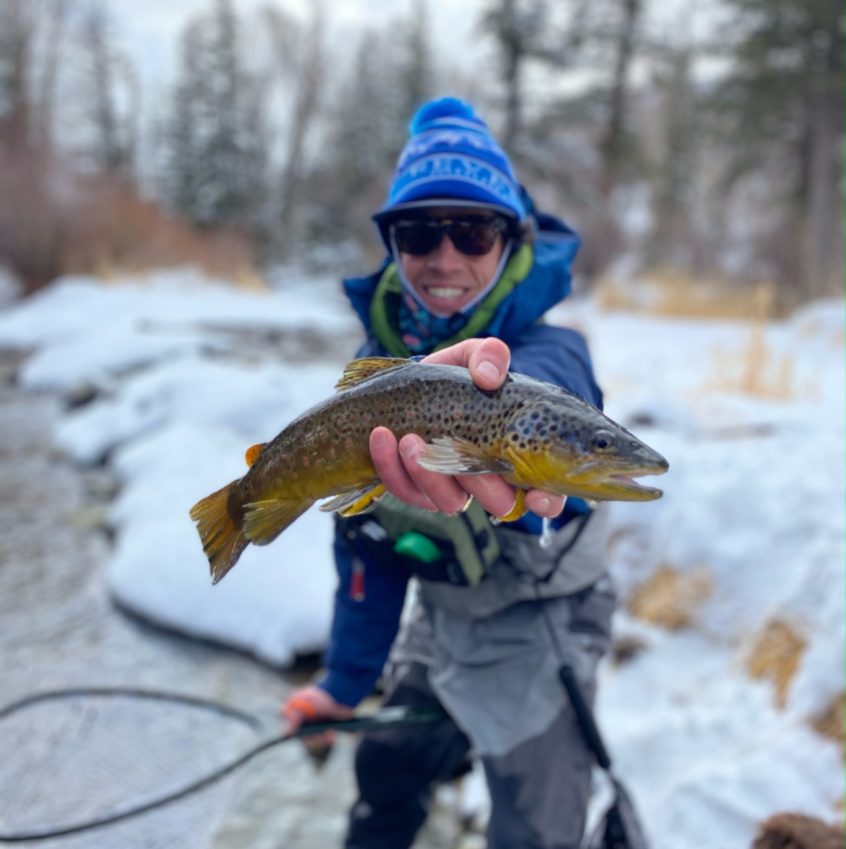Flows and Water Clarity
The Roaring Fork is running low and clear. Flows are 23 cfs below Maroon Creek, and 224 cfs at Emma.
Overview
Happy X Games to all! We’re excited to see all of the incredible things happening up on the mountain, but we certainly aren’t going to forget about the fish! The fishing has been really good this past week, and could get even better with warmer temperatures projected for next week. Right now, the fish are stacked up in slower, deeper water. Focus on deep holes and eddies near natural structure for the best results. During this time of the year, when you find one fish, you often find many — so make sure to cover water until you find success.
Common Hatches and Food Sources
Midges, Baetis, and Eggs.
Midge Larvae and Baetis nymphs are the main sources of food present in the upper fork right now. But, we’re also seeing some slightly larger mayfly and stonefly nymphs lingering on rocks and twigs. During this time of the year, trout occasionally feed on eggs, but it can be hit or miss. On warmer days, we’re seeing some fish rise intermittently to eat hatching midges. Sculpin are always present in the river, but only the most aggressive fish will bother to eat them this time of year.
Hot flies & Techniques
Nymphs
Midges and Baetis
Zebra Midge (black, gray, size 18-22), WD40 (black, gray, size 18-22), Top Secret Midge (gray, brown, size 18-22) RS2’s (cdc, crystal wing, black, gray, size 18-22), Juju Baetis (red, olive, black size 18-22).
Point Flies
“Frenchie” Tungsten jigs (yellow, brown, pink, size 14-18), Bead Head Rainbow Warrior (classic, purple, red, size 16-20), Eggs (chartreuse, peach, white).
Dries:
Griffith’s gnat (classic or hi-vis, 18-22), Element Hi-Vis Midge (black, size 20) Parachute Adams (18-20), BWO Hackle Stacker (18-20)
Streamers:
Motor Oil (black, size 6), Slumpbuster (natural, size 8-12), Thin Mint (size 6-10).
Techniques
Nymphing is the most productive technique during this time of year by far. Finding deep holding water and using weight to get your flies down will be crucial to success. Longer leaders and heavy split shot will help you get your flies in front of more fish. Leading with larger jig style patterns to help get smaller flies down deeper has been a very productive technique. With the cold temperatures, your floating line and line guides are at risk of freezing over, using ice off paste can help extend your time on the water.
On warmer days, keep an eye out for pods of rising fish. Small midges are the predominant hatch right now, so switching to small dry flies and fine tippet is your best chance at fooling fish. Small streamers are also an option this time of year, but be sure to focus your efforts on deep pools and structure.
Information About The Roaring Fork
The Roaring Fork River is a freestone river that runs 70 miles from Independence Pass through Aspen, Basalt, and Carbondale until it reaches its confluence with the Colorado River in Glenwood Springs. The cold, clean waters of this famous river support an incredible array of aquatic life including brown, rainbow and cutthroat trout. The Roaring Fork is designated as a “Gold Medal” fishery, meaning it offers some of the best trout fishing in the nation to beginners and seasoned anglers alike.
Written by Aspen Outfitting Company Staff, Photo by Rob Gonzalez

